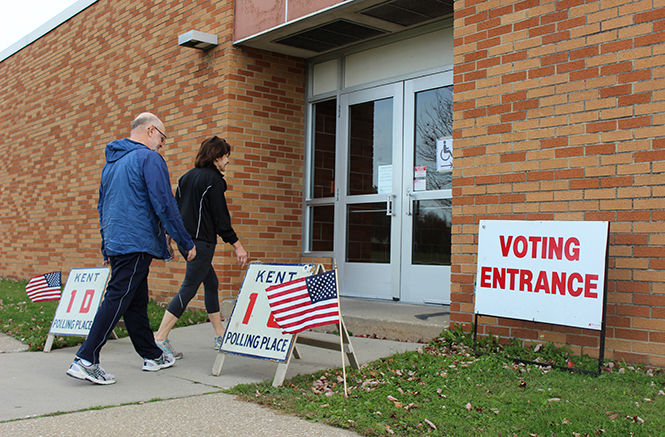College vote in minority during midterm elections
Kent residents John Ferlito and Linda Ferlito walk into the voting entrance at Theodore Roosevelt High School on Election Day, Nov. 4, 2014.
November 3, 2014
Midterm Election Day has arrived, and eligible voters will line up at the polls, but less than a quarter of college students will be there.
CIRCLE, a non-partisan youth voting research center out of the Jonathan M. Tisch College of Citizenship and Public Service at Tufts University, reported that during the 2010 midterm elections, only 20.7 percent of eligible youths voted compared to the 50.2 percent that voted during the presidential elections. A youth voter is considered to be ages 18 through 29.
// <![CDATA[
// ]]>
Abby Kiesa, youth coordinator and researcher for CIRCLE, said college voters say they don’t have time to vote or have work conflicts that keep them from the polls. She also said these problems cause youths not to register to vote.
One of the most common reasons for youths not registering to vote, even if they are eligible, is lack of interest or thinking their vote won’t matter.
“I’m not interested in politics,” freshman biochemistry major Jerod Burnett said. “I don’t think that much change comes from it.”
Kent State’s Undergraduate Student Government, along with several other student organizations, worked this semester to register eligible voters.
“(College students), as a voting block, don’t turn out enough for (midterm elections) to address our needs,” said Robert Lierenz, director of governmental affairs for USG. “If we turn out in masses, it will force politicians to vote in our favor.”
Midterm elections are also harder for youths to get excited about because they are not on a national scale.
“With midterm compared to presidential elections, there is less outreach to youth,” Kiesa said about the smaller scale of upcoming elections.
// <![CDATA[
// ]]>
Kent State College Democrats and Republicans tried to bring candidates to speak at the university. Some included the current Secretary of State Jon Husted, who will run for re-election, and Paula Prentice, a Summit County councilwoman running for the Ohio House of Representatives 36th District seat.
Keisa said despite outreach from campus political groups and encouragement to vote, young voters are still in the minority of voters during midterm elections.
“When there are competitive races, which you don’t often see in local elections, there is a higher turnout,” Kiesa said.
Contact Hannah Armenta at [email protected].

























